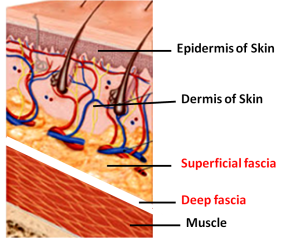 “Understanding Superficial Fascia: Our Body’s ‘Fluffy Onesie’
“Understanding Superficial Fascia: Our Body’s ‘Fluffy Onesie’
Superficial is an anatomical term that means closer to the surface, while fascia refers to a group of connective tissues that wrap things in the body.
Superficial fascia is our body’s version of the ugly duckling. Why? Because it is different from the other tissues. It is thick over much of the body and contains subcutaneous fat. In our Western culture’s preoccupation with thin, the superficial fascia has been persona non grata.
The War Against Our Sensitive Tissue
But the day has come when our duckling is turning into a swan. We’re recognizing the special and almost magical properties that superficial fascia contain.
The Magical Properties of Superficial Fascia
This is the tissue where acupuncture needles do their magic. Most of the lymphatic fluid flows through superficial fascia (about 70%), and other than the skin, this is the only tissue that surrounds the body in a single continuous layer—like a big fluffy onesie.
Superficial fascia is loaded with sensory structures that give us information about our movement and body position. But there’s more. It receives information that relates to perception and intuition. It’s how we know there’s a tiger hiding behind that bush.
To add to the mystery, anatomists don’t even agree on where it begins and ends.
Proper Care For Your Superficial Fascia
Caring for your superficial fascia is in your highest interest. Give it lots of movement. Both active movement with exercise and passive movement with massage. “For our body to move well, this tissue needs to be supple and have the right amount of mobility relative to its neighbour, the deep fascia, allowing some movement but providing healthy and needed limits,” shares Jeff.
When restricted, either through trauma or inactivity, movement is harder and limited. We feel it as stiffness. It makes for less resilience in falls and accidents, changes the path of movement at joints, and increases the harmful wear and tear on our parts.
Gentle Techniques for Fascial Health
How do you care for it? This fascia loves to be gently pinched, rolled and massaged. It does not love rough treatment. If you are mobilizing your own superficial fascia (highly recommended), when you feel resistance, just stop and hold it at that first edge of resistance. Most restrictions will release within a minute or so if there isn’t too much tension on it. Note: If you are on blood thinner medication, be sure to get instructions and supervision from one of your health professionals before taking this medication.
Moving Forward: Discoveries Yet to Come
There are many secrets yet to discover about superficial fascia. Expect the wisdom you receive from health and exercise experts to change as new knowledge is discovered and integrated. Find a new use for your foam roller that doesn’t involve crushing your sensitive tissues and re-traumatizing your existing restrictions, and you’ll be well on your way to moving well through the ages and sharing a secret kinship with swans.
For more information or to book an appointment with Jeff, contact our Cochrane practice today!
CONTACT US
